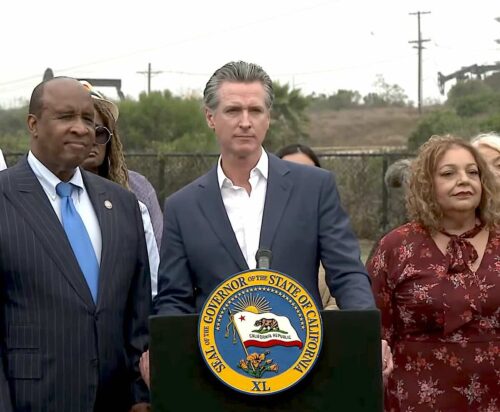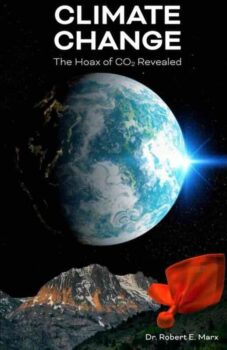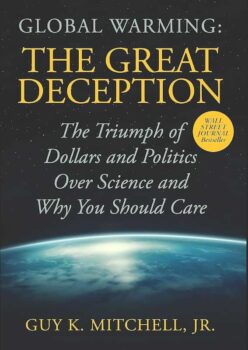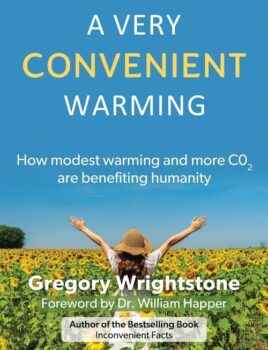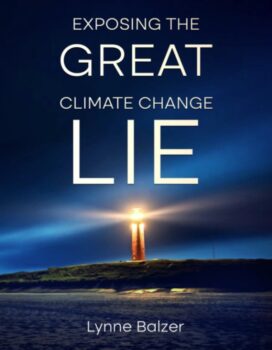
About 2.6 million years ago, the Earth descended into the Pleistocene Ice Age, after the Isthmus of Panama replaced the open seaway that had long linked the Atlantic and Pacific Oceans. This is only the fifth time in the planet’s 4.5 billion-year history that the Earth has succumbed to an ice age.
The Pleistocene has meant a colder, drier climate, with substantial glacial cover in the Northern Hemisphere. Glaciers themselves are simply the accumulation of successive layers of snowfall, compacted down into ice.
This snow and ice reflect solar radiation back into space, which helps to explain why ice ages often self-perpetuate for millions of years.
Over the past million years or so, a steady pattern has emerged in the current Ice Age. For 100,000 or so years, the Northern Hemisphere endures a continuous glacial period (an Ice Age). Then, it is interrupted by roughly 20,000 years of a warm, interglacial period.
When that warm era fades away, the cycle starts over again with the onset of another 100,000-year glacial period. This ice-age/warm-age pattern is called the Milankovitch Cycle, named after the Serbian astronomer who first recognized that variations (see Fig 1) in both the elliptical shape of the Earth’s solar orbit and a “wobble” in the tilt of the Earth’s axis could periodically align to interrupt glacial cycles.
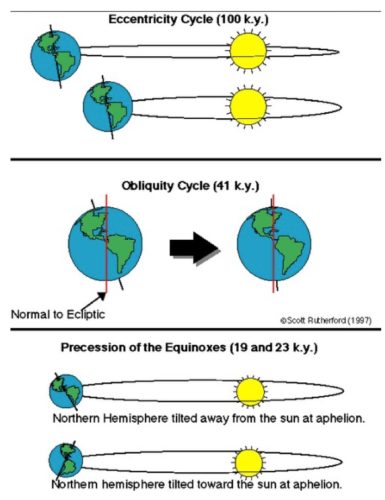
What Milankovitch realized was that, within the current Ice Age, there were recurring periods when sunlight was absolutely maximized in the summer months of the Northern Hemisphere, leading to progressive melting and retreat of the continental ice sheets.
Milankovitch theorized that, for a brief window of roughly 20,000 years or so, the Northern Hemisphere would experience warm weather during the “summer” months. These summers would come on gradually. But as each summer took place, the glaciers would warm and melt.
Then winter would come, and snow would return. But with each summer, there would be a successive diminishment of the glaciers, leading them to gradually retreat over a span of thousands of years.
It’s a remarkable pattern. For 100,000 years, the Northern Hemisphere endures a constant winter. Warm, wet air from the equatorial region rises northward and condenses as snowfall over present-day Canada, the northern portions of the United States, England, and northern Asia.
Because this snow never melts, it’s compacted down into ice. Over the course of 100,000 years, this ice builds up to roughly two miles in height. Accumulating height and weight force these growing ice sheets to spread out, sprawling across entire continents and actually depressing the continental crust.
During the most recent glacial period, ice sheets reached as far south as Chicago and New York City. Present-day Long Island represents the Laurentide Ice Sheet’s furthest glacial advance along the East Coast of North America. Long Island itself is simply a wide debris pile of dirt, sand, rocks, gravel, and boulders, all swept along in front of a massive, unstoppable wall of moving ice.
Because the glaciers never melt, there is a progressive transfer of water from the oceans to the ice sheets. At the peak of the most recent glaciation 20,000 years ago, ocean levels had dropped to roughly 390 feet lower than the present day.
The continental shelf surrounding the United States was exposed. Long Island itself was swept along on flat, exposed bedrock, not the present-day Atlantic Ocean—which was actually located far below the continental shelf.
The current interglacial period, the Holocene epoch, began to take shape roughly 18,000 years ago, as the climate slowly warmed. Two major interruptions in this warming trajectory occurred roughly 14,000 years ago and 12,000 years ago.
The more recent of the two episodes, the Younger Dryas, may have resulted from the release of melting glacial water into the Atlantic Ocean. The sudden introduction of huge volumes of cold, freshwater into the Atlantic interrupted the prevailing circulation of currents, forcing a rapid 1,200-year drop-off in temperatures.
The Northern Hemisphere’s recovery at the end of the Younger Dryas marks the more formally recognized starting point of the current Holocene interglacial period. Beginning at around 12,000 years ago, temperatures climbed rapidly into the temperate zone that marks the habitable living conditions still seen today.
It’s fascinating to consider that all of recorded civilization—indeed all of modern history—has only come about since the start of the Holocene. The emergence of a warmer, less hostile world allowed humanity to flourish.
Agriculture, including rice cultivation in China, first emerged as the glaciers were still retreating, some 14,000 years ago. The Neolithic Period itself emerged with the beginning of the Holocene, allowing for permanent shelters to be built, animals to be domesticated, and farms planted.
The retreat of the glaciers was not entirely benign, however. Many of the world’s ancient cultures contain stories of a great flood. Undoubtedly, there were several catastrophic incidents of glacial lakes, formed by the collection of melting ice, that gave way and flooded entire regions—and on an almost unimaginable scale.
Glacial Lake Missoula, which formed over portions of Northwest Montana and Northern Idaho, grew to a depth of 2,000 feet as melting glaciers filled up vast valleys. The lake remained dammed by the residual section of a glacier.
When the weight of the lake—estimated to have covered an area larger than present-day Lake Erie and Lake Ontario combined— finally overcame its ice dam, the resulting flood exploded across the eastern half of Washington State, essentially sweeping the entire landscape into the Pacific Ocean.
Such glacial lakes are presumed to have formed and released repeatedly during the formation of the Holocene. It’s likely that the same melting and flooding occurred across similar terrain during the initiation of the Earth’s previous interglacial period, the Eemian, roughly 130,000 years ago.
That interglacial period is believed to have been warmer than the present one, with temperate forests reaching as far north as present-day Norway. But the glacial lake patterns may have been similar, meaning that lakes and floods have razed continental surfaces countless times over the past million years.
The melting and flooding that took place during the early Holocene also explain the formation of several major geologic landmarks. The Black Sea filled with glacial meltwater roughly 8,000 years ago.
The Great Lakes of North America were first gouged by advancing glaciers, and then subsequently filled, tens of thousands of years later, by the meltwater of retreating glaciers.
The present-day Hudson River in New York State was gouged by glacial advance. It subsequently grew deeper and wider as it carried vast, roaring torrents of glacial meltwater downstream, finally spilling in a great waterfall from the continental shelf, raining down on the much shallower Atlantic Ocean.
The Beringia land bridge that joined Asia and North America gradually disappeared under the rising Pacific Ocean, eventually submerging for good 15,000 years ago.
As the Holocene finally emerged 11,700 years ago, the Woolly Mammoth grew extinct. It was one of many creatures incapable of handling the new climate of an interglacial period.
There is the ongoing question of whether the warmer summers and colder winters of the Holocene doomed the mammoth, or whether human hunters drove it to extinction.
There are estimates that hundreds of thousands of woolly mammoths remain smothered and entombed in massive dust piles that blew across the arid Siberian Tundra near the end of the last glacial period. These dust piles were subsequently buried by snow, with a few preserved mammoths finally emerging from melting ice during the more recent era of the Holocene.
The melting of glaciers also changed the composition of the North American continent. Icebergs detached themselves from retreating glaciers and floated along the lakes that formed above the northern states of present-day America.
Occasionally, these drifting icebergs would splinter apart, dislodging massive, car-sized boulders. These huge rocks would plummet to the bottom of glacial lakebeds that eventually formed the rolling land and forests of the northern United States.
The prairies and farmlands of America’s Central Plains are themselves the product of glacial till. During the glacial period, vast sand and gravel piles were pushed along in front of advancing glaciers.
Massive dust storms frequently blew these enormous heaps of crushed, pulverized, and powdered bedrock down across the middle section of the United States, distributing mineral-rich debris that would one day form the basis of deep, fertile farm soil.
As the glaciers finally retreated, and the Holocene took hold, global temperatures climbed significantly. This is because the window of peak summer warming grew progressively stronger as the Milankovitch Cycle reached its optimum.
Roughly 8,000 years ago, the Holocene reached its warmest period. This “Interglacial Maximum” spanned roughly 5,000 years, from approximately 9,000 years ago to 4,000 years ago.
Thanks to geologic proxy measurements of oxygen isotopes, researchers can estimate the temperature of the Holocene Optimum during this warmer, wetter period. The global climate was significantly friendlier for survival and made agriculture easier in areas that today consist of marginal farmland.
During the Holocene’s peak, the Sahara Desert was a prairie, and even a savanna in places, with flourishing civilizations and farming. In contrast, the current global climate is simply “too cold” to support the precipitation and weather patterns that supported the Sahara for almost 5,000 years during the Holocene Optimum.
After the Holocene passed its peak point, roughly 8,000 years ago, the global climate began to cool ever so slightly—beginning the long, slow march back toward a glacial period (see Fig 2). In tandem with this gradual decline in global temperatures came more pronounced and unpredictable swings of climate and weather.
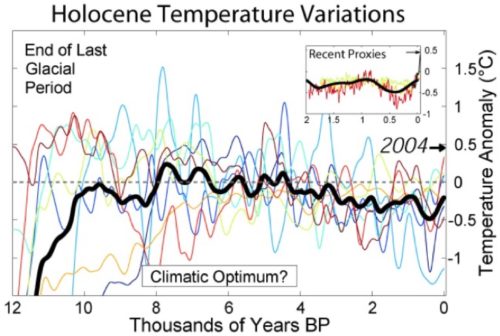
By 6,000 years ago, the Sahara was already shifting back toward desert conditions, forcing the mass-migration of nomadic people to the Nile River Valley. Swings in climate became more pronounced 4,000 years ago.
As the Holocene began to cool, and neo-glaciation began its almost imperceptible start, the global climate became more sensitive to changes in solar output. Variations in solar activity can be estimated back through geologic proxies of carbon and beryllium isotopes. They reveal intriguing correlations between solar activity and some of the warmer and cooler episodes of the more recent Holocene.
Roughly 2,000 years ago, solar output increased, leading to the “Roman Warm Period,” when the global climate is believed to have been notably warmer (see Fig. 3) than the present day.
But after roughly 150 years of temperate weather, global temperatures plummeted, leading to the Dark Ages. In fact, during a particularly brutal stretch of cold weather in 829 AD, the Nile River froze.
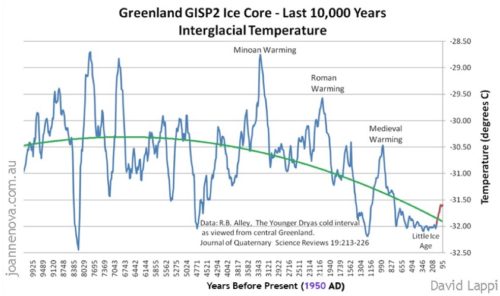
Such pendulum swings of warm/cold episodes become more pronounced as the Holocene moved (see Fig. 3, above) into its latter phase.
Within 300 years of the Nile River’s freeze, temperatures had rebounded, driven by a strong rise in solar output (see Fig. 4). The Medieval Warm Period that occurred roughly 1,000 years ago saw a warmer climate that allowed the Vikings to colonize Greenland.
Geologic proxies suggest that the Medieval Warm Period enjoyed warmer weather than today, observations that correspond with historical accounts in both China and Europe.
Whereas Greenland is inhospitable today, the Vikings were able to farm and raise cattle there 1,000 years ago. Similarly, England experienced conditions warm enough to allow the growth and harvest of large-scale vineyards.
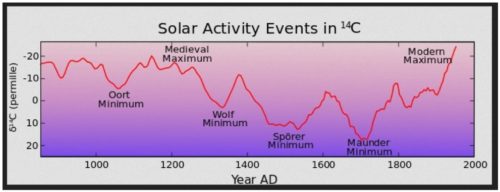
The warm climate of the Medieval Warm Period didn’t last, however. By the late 1200s, global conditions began to shift rapidly. Solar output declined, and marginal farmlands began to fail throughout Europe.
In the early 1300s, there was a marked climate shift (see Fig. 5), with Europe experiencing heavy rains and widespread famine. This was the start of several hundred years of unusually cold climate and reduced farm yields known as the “Little Ice Age.”
Three times through a roughly 500-year period recorded solar activity dropped to extremely low levels— the Sporer, Maunder, and Dalton Minimums. Exacerbating the generally cooler climatic conditions were repeated episodes of volcanic eruptions.
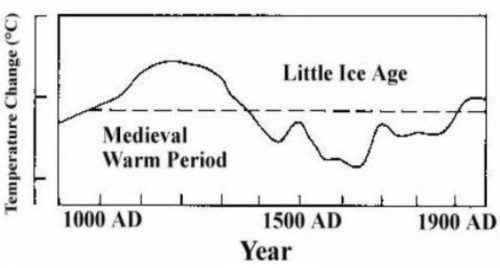
The Little Ice Age reached a brutal peak in the late 1600s and 1700s. Glaciers that had retreated during the Medieval Warm Period began to advance significantly.
Throughout the 1700s and into the 1800s, the Thames River in London froze during winter. In 1815, the Mount Tambora volcano in Indonesia exploded, adding a layer of aerosol particles to the atmosphere.
This led to a diminishment of global sunlight that yielded the “Year without a summer” in 1816—so named because New England experienced snowfall in June, and the ground of upstate New York remained frozen throughout the summer.
The Little Ice Age meant ongoing agricultural struggles and widespread starvation worldwide. But it didn’t mean a uniformly cold climate. The winter of 1683-1684 is considered to be the coldest in the English Instrumental Record.
But as the University of California’s Doug Macdougall notes in ‘Frozen Earth,’ “one of the warmest was just two years later in 1685-86.” Such is the continuing pendulum swings of late-stage Holocene weather, as the global climate grapples with the effects of slowly diminishing summer warmth.
The Little Ice Age is generally considered to have concluded by 1870. Solar output began to increase (see Fig. 4, above) considerably around that time, with global temperatures beginning their rise into what is now called the “Modern Warm Period.”
The Earth is now in the late stages of the Holocene interglacial period. What is intriguing to ponder is whether, in the next few thousand years, the global climate will shift for good, and the Earth will finally dive down into the next glacial period.
Steven Capozzola is a freelance writer who has spent the past 15 years working on issues related to manufacturing, global trade, and energy policies.


